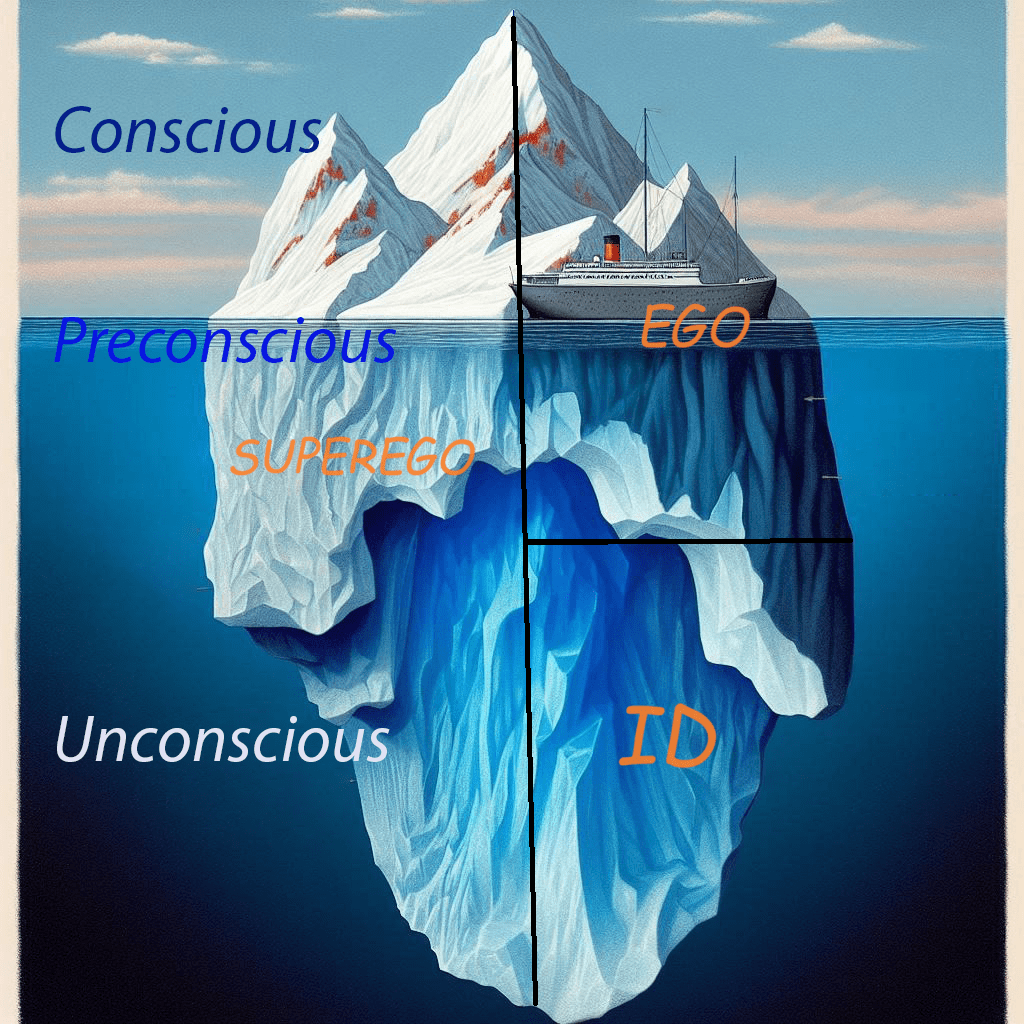Sigmund Freud, often referred to as the father of modern psychology, revolutionized our understanding of the human mind with his groundbreaking theory of psychoanalysis. Delving into the depths of the unconscious, Freud explored how our hidden desires, fears, and memories shape our behaviors and emotions. His concepts of the id, ego, and superego, along with techniques like dream analysis and free association, opened new pathways to understanding the complexities of the psyche.
Let’s uncover the fascinating world of Freud’s psychoanalysis, where the secrets of the mind are brought to light.
Chapter 1: The Mysterious Mind of Dr. Freud
In the bustling city of Vienna during the late 19th century lived a brilliant and ambitious neurologist named Sigmund Freud. Born in 1856 in the quaint town of Freiberg, Freud grew up in a household where his father’s strict authoritarian demeanor contrasted sharply with his mother’s loving and protective nature. This dichotomy profoundly shaped his understanding of human behavior and the inner workings of the mind.
Freud’s insatiable curiosity and determination led him to the University of Vienna, where he delved into the mysteries of the human brain. He specialized in neurology and eventually traveled to Paris to study under the renowned Jean-Martin Charcot, mastering the art of hypnosis. However, it was his collaboration with Josef Breuer that set the stage for his revolutionary ideas. Together, they developed the technique of catharsis, using it to treat hysteria by helping patients release repressed emotions.
Chapter 2: Unveiling the Unconscious
Freud’s fascination with the human psyche led him to propose that our minds consist of three distinct levels: the conscious, the preconscious, and the unconscious. The unconscious, he believed, was a reservoir of primitive drives, urges, and instincts, hidden from our awareness yet exerting a powerful influence over our thoughts and actions. To navigate the complexities of the mind, Freud introduced the concept of the id, ego, and superego.
- Id: The id is the primal part of our psyche, operating on the pleasure principle. It demands immediate gratification of its desires, driven by the basic instincts of sex and aggression.
- Ego: The ego, operating on the reality principle, mediates between the unrealistic demands of the id and the external world. It strives to satisfy the id’s desires in socially acceptable ways.
- Superego: The superego represents the moral and ethical standards imposed by society. It consists of the conscience, which punishes misbehavior with feelings of guilt, and the ego-ideal, which rewards adherence to moral standards.

Easy examples for Id, Ego and Superego:
- Id: Imagine a toddler in a supermarket who sees a candy bar. They immediately grab it and start eating without thinking of the consequences. This impulsive behavior is driven by the id, seeking instant gratification.
- Ego: As the toddler grows, they learn to ask their parents or use allowance money to buy the candy bar. The ego balances their desire with social rules and norms.
- Superego: As an adult, the person might see a candy bar but resist buying it because they are on a diet. The superego reminds them of their health goals, guiding their decision to resist temptation.
Chapter 3: The Battle Within
Freud’s theory of personality dynamics emphasized the constant struggle between the id, ego, and superego. This internal conflict often gives rise to anxiety, which the ego manages through various defense mechanisms:
- Repression: The ego pushes unacceptable thoughts and feelings into the unconscious.
- Example: Jane experienced a traumatic car accident as a child but has no memory of it as an adult. Her mind has repressed the painful memory to protect her from the emotional distress.
- Reaction Formation: An individual behaves in a way opposite to their true feelings.
- Example: Mark feels angry towards his boss but instead of expressing his anger, he behaves overly friendly and compliments his boss excessively. His behavior is the opposite of his true feelings.
- Displacement: Redirecting emotions from a threatening object to a safer one.
- Example: Sarah is angry with her manager after a tough day at work. Instead of confronting her manager, she goes home and takes out her frustration by arguing with her partner. She displaces her anger onto a safer target.
- Sublimation: Transforming unacceptable impulses into socially acceptable actions.
- Example 1: Tom has aggressive impulses but instead of acting on them, he channels his energy into playing competitive sports. This way, he transforms his unacceptable impulse into a socially acceptable activity.
- Example 2: Emily feels deep emotional turmoil and intense feelings that she finds difficult to express directly. Instead of letting these feelings overwhelm her, she channels them into creating powerful and evocative paintings. Her artwork becomes a way to transform her intense emotions into something beautiful and socially valued.
- Fixation: The ego stays at a current psychological stage to avoid anxiety.
- Example: Consider John, an adult who experienced inconsistent nurturing during the oral stage (0-1 year). Due to irregular feeding, he developed an oral fixation. As an adult, John smokes, chews gum, bites his nails, and snacks compulsively, especially when stressed. These behaviors mimic the soothing effect of being fed as an infant, providing him comfort and security.
- Regression: Reverting to an earlier developmental stage during stress.
- Example: After a stressful day, a grown adult might curl up in bed with a stuffed animal, seeking the comfort they felt as a child. They regress to an earlier stage for comfort and security.
- Projection: Seeing in others what we find unacceptable in ourselves.
- Example: Lisa often accuses others of being selfish, but she struggles with her own selfish tendencies. She projects her own undesirable traits onto others to avoid facing them in herself.
- Introjection: Taking on qualities, mannerisms, values, or lifestyles of others.
- Example: After spending a lot of time with a confident and assertive friend, John starts adopting similar behaviors and attitudes. He introjects these qualities into his own personality to feel more secure.
Freud believed that our early childhood experiences play a crucial role in shaping our personality. He proposed the psychosexual stages of development, each characterized by the focus of libido on different areas of the body:
- Oral Stage (0-1 year): Pleasure centers on the mouth. Fixation at this stage can lead to oral behaviors in adulthood, such as smoking or overeating.
- Example: An infant derives pleasure from activities involving the mouth, such as sucking on a bottle, breastfeeding, or putting objects in their mouth. If an individual becomes fixated at this stage due to overindulgence or frustration, they might develop habits like nail-biting, smoking, or overeating in adulthood, seeking oral stimulation to satisfy their unresolved needs.
- Anal Stage (1-3 years): Focus on bowel and bladder control. Fixation can result in anal-retentive (orderly, obsessive) or anal-expulsive (messy, disorganized) traits.
- Example: A toddler finds pleasure and a sense of accomplishment in learning to control their bowel movements during toilet training. If fixated at this stage, an individual might exhibit traits of being excessively neat, organized, and perfectionistic (anal-retentive) or conversely, messy, disorganized, and rebellious (anal-expulsive). For instance, someone who was harshly toilet trained might grow up to be overly concerned with cleanliness and order.
- Phallic Stage (3-6 years): The Oedipus complex arises, where children experience unconscious desires for the opposite-sex parent and hostility towards the same-sex parent.
- Example: A child begins to recognize anatomical differences between genders and develops a subconscious sexual attraction towards the opposite-sex parent (Oedipus complex for boys and Electra complex for girls). They might express this through behaviors like wanting to “marry” the parent of the opposite sex and compete with the same-sex parent for attention. Successfully navigating this stage helps them identify with their same-sex parent and develop a healthy adult gender identity. A fixation here might result in difficulties with authority figures and unresolved sexual identity issues.
- Latency Period (6-puberty): Sexual impulses are repressed, allowing the child to focus on social and intellectual skills.
- Example: During this period, sexual urges are repressed, and children focus on developing skills and knowledge. They build friendships, engage in sports, and pursue hobbies, learning to interact with peers and form social bonds. This stage is crucial for developing self-confidence and social skills. For instance, a child might join a sports team, enhancing their ability to work in groups and form cooperative relationships.
- Genital Stage (puberty onward): Sexual reawakening, directed towards peers. Successful navigation of earlier stages leads to a well-balanced individual.
- Example: As adolescents enter puberty, they experience a resurgence of sexual interests directed towards peers. They start forming romantic and sexual relationships. Successful navigation of this stage leads to the ability to love and work productively. For example, a well-adjusted adult may establish healthy romantic relationships, maintain a satisfying career, and form deep, meaningful friendships. Failure to navigate this stage effectively might result in difficulties in relationships or sexual dysfunction.
Chapter 4: Exploring the Unconscious
Freud introduced several methods to explore the unconscious mind, including dream analysis and free association. He believed that dreams were the “royal road to the unconscious,” providing valuable insights into repressed desires and unresolved conflicts. In free association, patients were encouraged to speak freely about whatever came to mind, revealing hidden thoughts and feelings.
Chapter 5: The Legacy of Freud’s Psychoanalysis
Freud’s ideas revolutionized the field of psychology and laid the groundwork for modern psychoanalysis. Despite facing criticism and controversy, his theories on the unconscious mind, defense mechanisms, and psychosexual development have had a lasting impact on psychotherapy, literature, and cultural studies.
Freud’s legacy continues to influence contemporary thought, reminding us of the profound complexities of the human mind and the enduring quest to understand our inner selves. Through his pioneering work, Freud opened the door to the unconscious, inviting us to explore the depths of our own psyches and uncover the hidden forces that shape our behavior.













